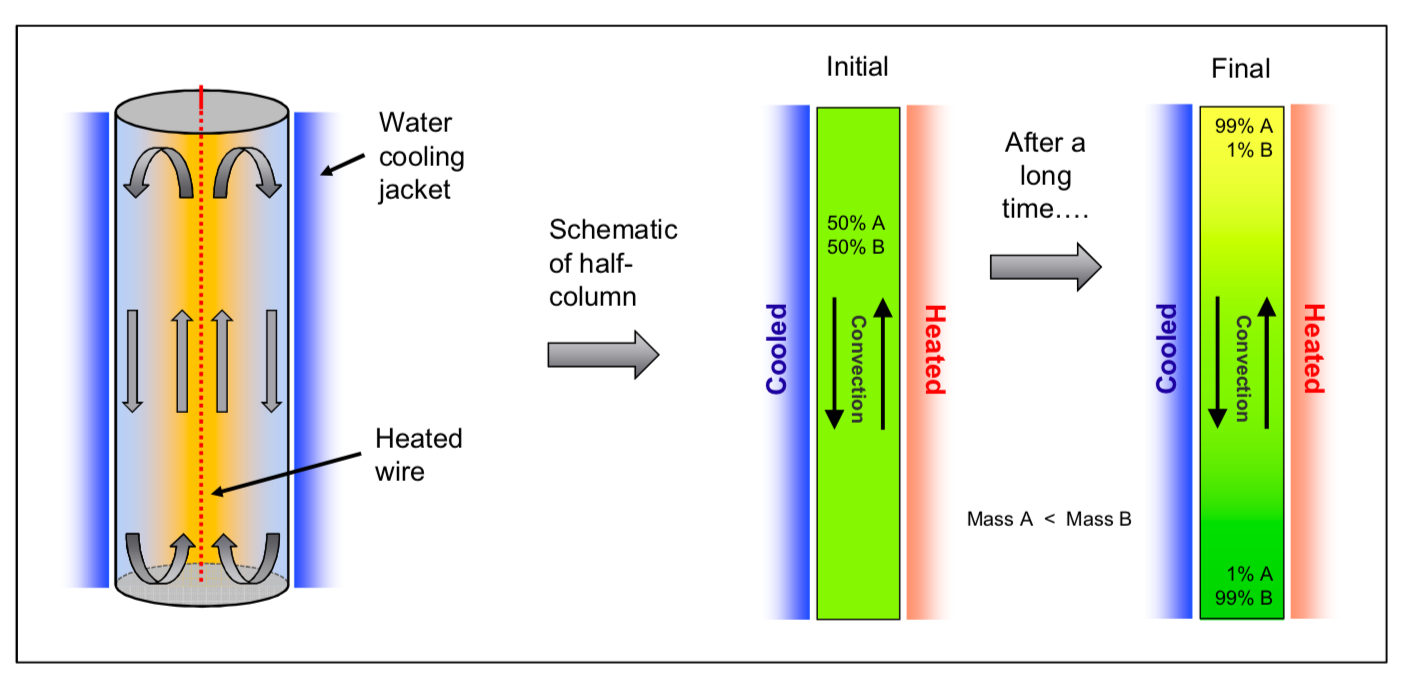-
-
August 19, 2020 at 7:49 pm
KmiloS
SubscriberHi all,
I'm working in a simulation of the Clusius-Dickel column, which use thermal diffusion and convection to separate the species of a gas mixture (Fig.1). The main problem is that convection does not move the agglomerate species on the hot/cold walls and I don't know why this happen. If someone could help me with some insight I would really appreciate it.
The geometry used in the simulation is a 2-d view of two concentric cylinders, one of which is at 1200 K and the other is at 300K. This creates a temperature gradient along the radial direction that makes thermal diffusion important. Then, due to thermal diffusion, the lighter specie (H2 in this case) agglomerate in the hot walls (inner cylinder) and the heavier specie (Argon in this case) agglomerate in the cold wall (outer cylinder). Fig. 2 shows the distribution of H2 enrichment (%) in the column.
Because one have a zone with a hot gas (H2) that is less dense, convection will transport this gas up and the cold gas (more dense) down. Fig. 3 shows that in fact there is a velocity induced by convection, but this velocity does not affect the agglomeration of species. This is what I think is wrong, because the species would have to move because of convection (and this is really what happen in reality).
Thanks,
Camilo
August 20, 2020 at 10:17 amRob
Forum ModeratorIn Fluent we assume species will mix, so once they're in a mixture they'll stay that way. In your model you may need to look at the multiphase approach, but that then losses the diffusion effects. nAugust 20, 2020 at 10:40 pmKmiloS
SubscriberHi Rob,nThanks for your answer. In this case the mixture doesn't stay the way that was set initially because of thermal diffusion effect. The mixture I used was 95% Argon gas an 5% H2 gas. Due to thermal diffusion molar fraction of Ar and H2 change. This is shown in Fig.2, where near the hot wall (in red) hydrogen molar fraction increased by 31% aprox. So my main problem is with convection. Although there is a velocity field induced by gravity, the species don't seem to be affected by it and I don't know how to fix this problem. nHave a nice day,nnCamilonAugust 21, 2020 at 1:07 amKarthik Remella
AdministratorHow does your diffusion compare with your convective terms? Are they comparable? nThanks.nKarthiknAugust 21, 2020 at 3:00 amKmiloS
SubscriberHi Karthik,nThansk for replying. Diffusion phenomena (i.e Fickian diffusion and thermal diffusion) produces masses flux two orders of magnitud higher than convection. Nonetheless diffusion occurs primarily along the radial direction, leaving convection the dominant contribution to mass flux in the vertical direction. nKind regards,nCamilonAugust 25, 2020 at 11:16 amKarthik Remella
AdministratorHow long did you run your simulation and how does it compare with the physical time scales of your problem?nThanks.nKarthiknOctober 7, 2020 at 9:57 pmKmiloS
SubscriberHi Karthik,nSorry for my huge delay in answering. You were right, by increasing the value of gravity the time scale of the problem decrease and the separation effect could be seen.nThank you so much for your help, you solved my problem!nnHave a good day,nnCamilonOctober 7, 2020 at 10:18 pmKarthik Remella
AdministratorExcellent! Good to know.nBest,nKarthiknViewing 7 reply threads- The topic ‘Convection in a Clusius-Dickel column’ is closed to new replies.
Ansys Innovation SpaceTrending discussionsTop Contributors-
3597
-
1283
-
1117
-
1068
-
983
Top Rated Tags© 2025 Copyright ANSYS, Inc. All rights reserved.
Ansys does not support the usage of unauthorized Ansys software. Please visit www.ansys.com to obtain an official distribution.
-


Ansys Assistant

Welcome to Ansys Assistant!
An AI-based virtual assistant for active Ansys Academic Customers. Please login using your university issued email address.
Hey there, you are quite inquisitive! You have hit your hourly question limit. Please retry after '10' minutes. For questions, please reach out to ansyslearn@ansys.com.
RETRY








